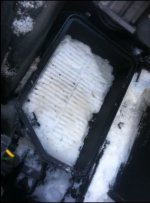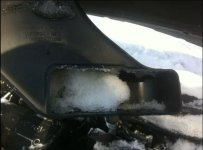7
You are using an out of date browser. It may not display this or other websites correctly.
You should upgrade or use an alternative browser.
You should upgrade or use an alternative browser.
K&N filters opinions
- Thread starter Mikejt1954
- Start date
OLD MEN RULE
Go Kart Champion
- Location
- ROCKFORD IL.
- Car(s)
- 2019 GTI S
I'm about to replace my OEM engine air filter with an OEM VW paper filter and leave the snow grate out and see if the engine explodes
this is in the pursuit of science.
this is in the pursuit of science.
2LEEGIT
Go Kart Champion
- Location
- City of Angels
- Car(s)
- GTI MK7
What IS the real function for the "snow grate"? I used to live in a high snow area and it was never a problem with other cars I've owned with similar designs.
https://www.autos.ca/forum/index.php?topic=72894.0
Attachments
tigeo
Autocross Champion
- Location
- Richmond, VA area
You mean their intake or their filters in general? I'd assume the "filter on a stick" intake is the same as everyone else's.Can’t find any real mention on K&N filters on a Golf R. I’d appreciate anyone’s comments. $350 doesn’t sound like a lot, but only if it works as advertised. Thanks in advance for any comments
The filters - I've used K&N filters in every vehicle I've owned for the last 25 years without issue. Here where I live, low dust, clean them/re-oil every 50K seems to work for my panel/drop-ins. The exposed once will need it more frequently. Clearly, they will have less filtering efficiency vs. paper but the difference isn't, IMHO, an issue. My used oil analysis always show low-to-normal Si values which many point to as the indicator for dust etc. in your oil from getting past the filter. The concern with MAF isn't an issue on MK7 as we don't have one and my feeling has always been this is mostly related to MAF's normal failure rate being blamed by coincidence on K&N; the air flow required to pull oil off the filtering media is well beyond anything your car can do.
Last edited:
aloha_from_bradley
Autocross Champion
- Location
- AZ
You mean their intake or their filters in general? I'd assume the "filter on a stick" intake is the same as everyone else's.
The filters - I've used K&N filters in every vehicle I've owned for the last 25 years without issue. HEre wher eI live, low dust, clean them/re-oil every 50K seems to work for my panel/drop-ins. The exposed once will need it more frequently. Clearly, they will have less filtering efficiency vs. paper but the difference isn't, IMHO, an issue. My used oil analysis always show low-to-normal Si values which many point to as the indicator for dust etc. in your oil from getting past the filter. The concern with MAF isn't an issue on MK7 as we don't have one and my feeling has always been this is mostly related to MAF's normal failure rate being blamed by coincidence on K&N; the air flow required to pull oil off the filtering media is well beyond anything your car can do.
My feelings and experience echo this. Though, I have seem people oversaturate K&N filters to the point that they drip onto the ground underneath the car. You can prevent this by using the aerosol version and just spray a light dusting onto the filter rather than the stuff in the bottle. But yeah, I've had K&N filters in my cars for 20 years and have not once had an issue.
19birel
Autocross Champion
- Location
- Pittsburgh
- Car(s)
- MK7.5 - MK4 - B8.5
My go-to has been BMC, which is an oiled drop-in much like the K&N stuff. Porsche uses these filters from factory in the GT3RS, so if they meet Porsche OEM quality standards I feel comfortable putting them in my cars. BMC filters are also used in a lot of disciplines of high level motorsport. Unless evidence from my upcoming Blackstone lab report points to it being an issue I'll keep running them.
BMC or K&N you'll be fine either way IMO
BMC or K&N you'll be fine either way IMO
tigeo
Autocross Champion
- Location
- Richmond, VA area
The spray oil is great and makes it easy to do it correctly/not overdo it.My feelings and experience echo this. Though, I have seem people oversaturate K&N filters to the point that they drip onto the ground underneath the car. You can prevent this by using the aerosol version and just spray a light dusting onto the filter rather than the stuff in the bottle. But yeah, I've had K&N filters in my cars for 20 years and have not once had an issue.
2LEEGIT
Go Kart Champion
- Location
- City of Angels
- Car(s)
- GTI MK7
PAM is my go to application.The spray oil is great and makes it easy to do it correctly/not overdo it.
Al_in_Philly
Autocross Newbie
- Location
- Philadelphia USA
Regarding oiled air filters. Remember the good old days of the pandemic, and everyone was looking for N95 masks? Well, those N95 masks had gaps between the fiber elements of around 3 microns. But the coronavirus had a diameter of only 1 micron. How could those masks keep 95% of the viruses in the air from passing through? I couldn't figure it out, so I did some research, which is germane to the subject of air filters. Apparently, the turbulence in the airflow through a surgical mask (or any filter element) causes the particulate matter to hit the fibrous material almost always, and since the coronavirus had small dendrites poking out from the core, they would get stuck on the fibers of the mask and not pass through. And though things like dust and the other contaminants in the air are far more regular in shape than a coronavirus, when they hit the gooey oil on the filter element, they too stick and don't pass through either. That's how oiled air filters can be more porous, and thus flow more air than a paper filter, yet catch almost as much of the particulate matter in the air before it reaches your engine--provided that the filter is coated with the requisite amount of oil.
Your nose works in pretty much the same way. The mucus in your nose coats the hair filaments in your nasal passages, and when you take in air through your nose most of the particulate matter becomes caught on those mucus-covered hairs, never making their way into your lungs. We make that ugly green snot, which collects into boogers, for a very good reason.
Just an FYI
Your nose works in pretty much the same way. The mucus in your nose coats the hair filaments in your nasal passages, and when you take in air through your nose most of the particulate matter becomes caught on those mucus-covered hairs, never making their way into your lungs. We make that ugly green snot, which collects into boogers, for a very good reason.
Just an FYI
Last edited:
tigeo
Autocross Champion
- Location
- Richmond, VA area
This concept is lost on so many here...."buT I caN SeE thROUgh iT HolD IT Up to A ligHt". Yes....that's what the oil is for....Regarding oiled air filters. Remember the good old days of the pandemic, and everyone was looking for N95 masks? Well, those N95 masks had gaps between the fiber elements of around 3 microns. But the coronavirus had a diameter of only 1 micron. How could those masks keep 95% of the viruses in the air from passing through? I couldn't figure it out, so I did some research, which is germane to the subject of air filters. Apparently, the turbulence in the airflow through a surgical mask (or any filter element) causes the particulate matter to hit the fibrous material almost always, and since the coronavirus had small dendrites poking out from the core, they would get stuck on the fibers of the mask and not pass through. And though things like dust and the other contaminants in the air are far more regular in shape than a coronavirus, when they hit the gooey oil on the filter element, they too stick and don't pass through either. That's how oiled air filters can be more porous, and thus flow more air than a paper filter, yet catch almost as much of the particulate matter in the air before it reaches your engine--provided that the filter is coated with the requisite amount of oil. Just an FYI.
Al_in_Philly
Autocross Newbie
- Location
- Philadelphia USA
To be fair, I needed to see some illustrations in technical papers before I fully got it. Plus, there is a limit as to how well an oiled element will catch particulate matter. There is always a trade off between filtration and airflow. But, as many have found out, a reasonably good oiled air filter can provide adequate filtration and also pass through more air. I'm running an AFE Magnum Flow oiled filter, as in testing, it filtered more than a K&N drop in, yet flowed almost as well. It's all about balance for me, as I don't track my car, yet plan on keeping it a long time.This concept is lost on so many here...."buT I caN SeE thROUgh iT HolD IT Up to A ligHt". Yes....that's what the oil is for....
kevinkar
Drag Racing Champion
- Location
- United States
You're neglecting the fact the 3 micron Coronavirus particles are not floating free and are instead suspended in people's breath, sneeze droplets, etc. THOSE carriers are way bigger than 3 microns and are what the masks were trapping and stopping thus preventing the individual virus particles making it through.Well, those N95 masks had gaps between the fiber elements of around 3 microns. But the coronavirus had a diameter of only 1 micron. How could those masks keep 95% of the viruses in the air from passing through?
Al_in_Philly
Autocross Newbie
- Location
- Philadelphia USA
You're absolutely right about the Coronavirus almost always being part of some amalgamation of other particulate matter. But the research that I read was from engineering journals, describing how the turbulence within filter systems causes particles to get caught on filter fiber elements even when they are smaller than the openings between those fibers. Those articles weren't focused on masks and Coronaviruses, but were referenced in public health articles discussing prophylactics for mitigating the transmission of Coronaviruses. Flow dynamics in turbulent systems is really chaotic and quite interesting to delve into, especially when you're locked up in your home for days on end. LOLYou're neglecting the fact the 3 micron Coronavirus particles are not floating free and are instead suspended in people's breath, sneeze droplets, etc. THOSE carriers are way bigger than 3 microns and are what the masks were trapping and stopping thus preventing the individual virus particles making it through.
kevinkar
Drag Racing Champion
- Location
- United States
I run a 3D print lab and, unfortunately, had to go in every day to actually TOUCH the printers all during Covid while all my other coworkers were able to stay at and work from home. For almost 4 years I worked alone in the lab and only recently has everyone started coming back in! So I didn't get to make sourdough bread, get tired of my wife, make puzzles, watch everything on Netflix........especially when you're locked up in your home for days on end. LOL

